Oskar Kokoschka
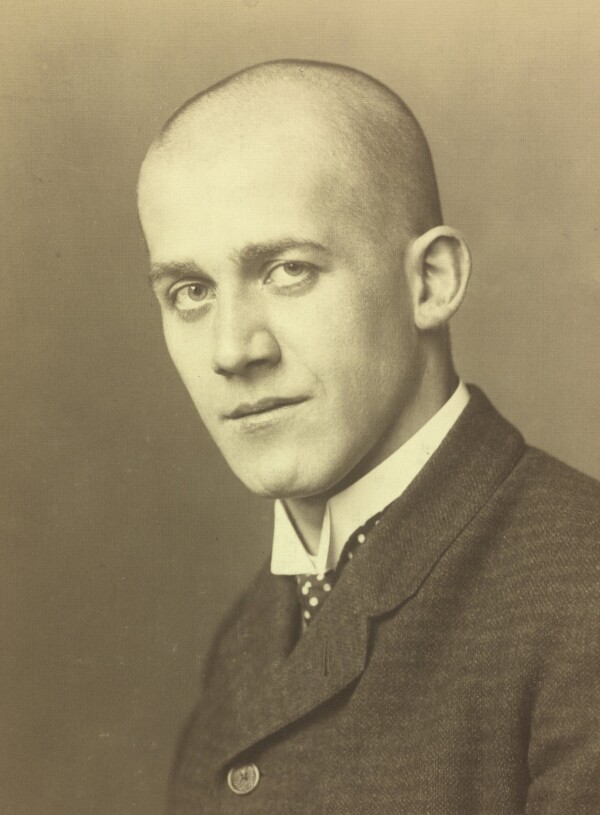
Oskar Kokoschka, photographed by Wenzel Weis, 1909
© Picture Archives and Graphics Department, Austrian National Library

Oskar Kokoschka: Postcard "Flute player and bats" from the Wiener Werkstätte, 1907
© Klimt Foundation, Vienna
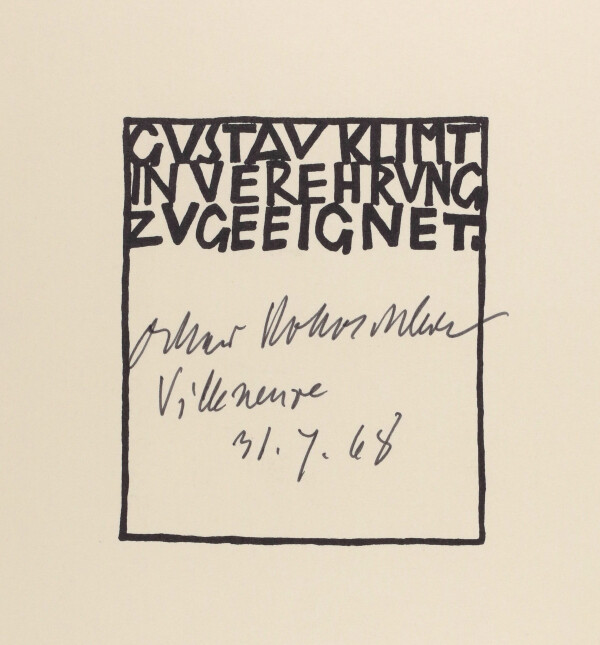
Oskar Kokoschka: Dedication sheet for Gustav Klimt in The Dreaming Boys, 1908/1968
© Klimt Foundation, Vienna
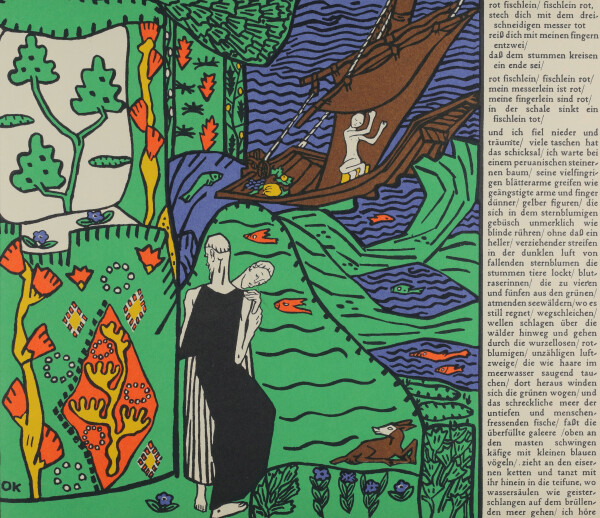
Oskar Kokoschka: The Sailing Ship from The Dreaming Boys, 1908
© Klimt Foundation, Vienna
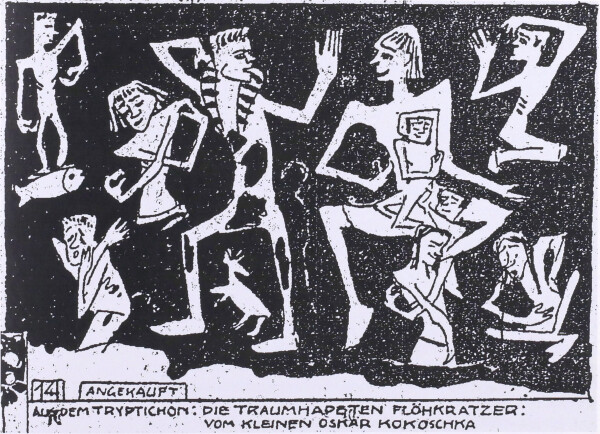
Theo Zasche: Detailed caricature of the tapestry design Die Traumtragenden by Oskar Kokoschka, in: Illustriertes Wiener Extrablatt, Vienna, June 28, 1908, p.5
© Klimt Foundation, Vienna
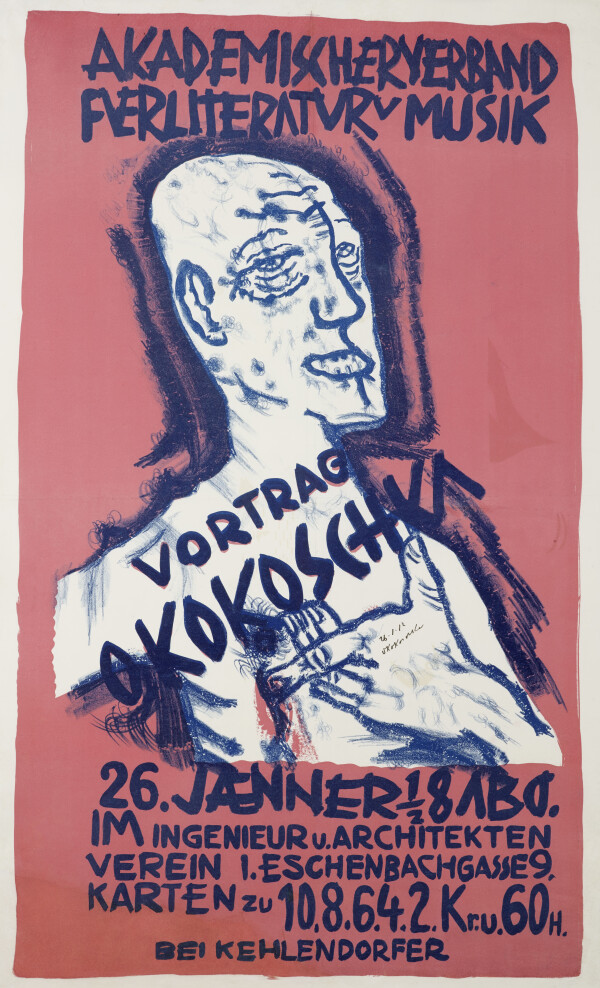
Oskar Kokoschka: Poster "Self-portrait with hand on chest" for a lecture at the Academic Association for Literature and Music, 1911/12
© Klimt Foundation, Vienna

Oskar Kokoschka: The painter Carl Moll, 1913
© Library of the Belvedere, Vienna
Oskar Kokoschka, “the youth of the Sturm und Drang era,” is considered one of the leading Austrian Expressionists. His art was rooted in Viennese Jugendstil, and nourished through his connections with the Wiener Werkstätte and Gustav Klimt.
Oskar Kokoschka was born on 1 March 1886 in the Lower Austrian town of Pöchlarn, the son of Gustav and Maria Romana Kokoschka (née Loidl). The family, who hailed from Prague, moved to Vienna the following year. After his graduation from secondary school (Vienna-Währing, 19th District), he studied from 1904 at the Imperial-Royal School of Arts and Crafts with the help of a state scholarship.
Kokoschka and the Wiener Werkstätte
Carl Otto Czeschka and Bertold Löffler were among Kokoschka’s teachers. This afforded him a direct connection to the Wiener Werkstätte and to Gustav Klimt. Kokoschka would eventually be able to experiment with various design media for this innovative collective, primarily designing postcards, but also pictorial broadsheets and fans. His fairytale, visualized with moveable figures and transparent color drawings, Das getupfte Ei [The Speckled Egg] premiered in 1907 at the newly opened Kabarett Fledermaus, though this performance was not crowned with success.
“Dedicated to Gustav Klimt in Admiration”
Latest in 1907, Kokoschka began working on Die träumenden Knaben [The Dreaming Boys], a publication initially conceived as a children’s book. This commission by Fritz Waerndorfer, or the Wiener Werkstätte respectively, promoted his artistic development. First Expressionist tendencies began to manifest. The work was published in the spring of 1908 in a limited edition. O. K., as he signed his works, dedicated this art book to Klimt:
“Dedicated to Gustav Klimt in admiration.”
Kokoschka likely also expressed his admiration for the genius painter in a depiction from the book showing two men and called The Sailboat. Sales of the book were slow, prompting Waerndorfer to cynically remark to Czeschka:
“[…] People are stupid, you can sell them champagne for 2000 crowns in one night, only for them to pee it out in the morning, but to sell 2000 crowns worth of books by Kokoschka is something you won’t manage in 10 years.”
“Otherwise, Kokoschka is the One Raising Hell at the Kunstschau”
Kokoschka was invited by the Klimt Group to contribute a poster design for the exhibition “Kunstschau Wien” in 1908, and was given the chance to exhibit several works. Among these works, most of which were shown in room 14, were drawings, Die träumenden Knaben and the scandalous large-scale triptych Die Traumtragenden [The Dream Carriers] (date and whereabouts unknown). While this draft, intended for a Gobelin tapestry, is considered lost, we have a basic idea of what it looked like owing to a detailed caricature by Theo Zasche and a few contemporary descriptions. The distorted rendering of the figures caused a scandal, with the artist encountering increasing criticism even within the Klimt Group. According to the recollections of Berta Zuckerkandl, however, Klimt staunchly defended Kokoschka against these critics:
“We are obligated to give a great talent the opportunity to express itself. Kokoschka is the greatest talent of the young generation. Even if we ran the risk of our Kunstschau being destroyed, well then, let it be ruined. But at least we will have done our duty.”
Despite all criticism, the “Kunstschau Wien” marked Kokoschka’s breakthrough. His drawings were bought by Emil Orlik, Kolo Moser and Franz Metzner, and the fact that “on the opening day, all of his works boasted the note ‘sold’” made a great impact. O.K. also met Adolf Loos, an underestimated and quiet admirer of Klimt’s, who at the same time was an antipode to the prevalent concept of art espoused by the Wiener Werkstätte and the Vienna Secession.
The “Chief Wildling” Kokoschka Breaking Free
In 1909, Kokoschka featured with several works in the exhibition “Internationale Kunstschau.” Despite a lot of resistance, the presentation included the premiere of his play Mörder, Hoffnung der Frauen [Murderer, the Hope of Women], for which he also designed the poster. Kokoschka provoked audiences with his art once more. Loos became his mentor that year. He helped O. K. to “liberate himself from the School of Arts and Crafts” and to “rid himself of the Wiener Werkstätte.” During the following period, Kokoschka met Karl Kraus and his circle, as well as the gallery owners and future promoters Herwarth Walden and Paul Cassirer. Franz Hauer, an Egon Schiele supporter, and Dr. Oskar Reichel, who acted as patron to Schiele and Max Oppenheimer, were also among his advocates. Additionally, the Akademischer Verband für Literatur und Musik in Wien [Academic Association for Literature and Music in Vienna] provided him with an important network. He gave lectures as part of the association, such as Von der Natur der Geschichte [Of the Nature of History], for which he created a poster featuring a self-portrait.
The Subsequent Years
Following prolonged stays in Switzerland and Berlin, O. K. participated in 1911 in the “Sonderausstellung Malerei und Plastik” [“Special Exhibition of Painting and Sculpture”] of the Hagenbund, but without much success. Kokoschka’s expressive paintings divided the public once again. His financial situation was precarious, and even his teaching activities as an assistant at the School of Arts and Crafts from 1912 to 1913 did little to alleviate this. Around this time, he got caught up in an excessive love affair with Alma Mahler. This relationship inspired a highly productive period in his oeuvre, during which he created works such as The Bride of the Wind (1913, Kunstmuseum Basel). In 1914, he was asked to portray the Wiener Werkstätte testimonial Friederike Maria Beer. Schiele had been commissioned to paint her likeness shortly before, Klimt shortly afterwards. However, the outbreak of World War I thwarted the project. Alma and O. K. separated in 1915.
In early 1916, Kokoschka participated in the legendary exhibition “Wiener Kunstschau in der Berliner Sezession” [“Vienna Kunstschau at the Berlin Secession”]. He featured in this presentation with seven works, among them the portrait The Painter Carl Moll (1913, Österreichische Galerie Belvedere, Vienna). Franz Servaes’s remark in a review of the exhibition pointed the way ahead:
“It seems that his great power comes through much more clearly now in the area of portrait, both with regards the art of characterization and in terms of a brilliant painterly style.”
Schiele, another representative of the young generation, featured in this exhibition alongside the grand seigneur of Austrian art: Gustav Klimt. Schiele’s work Levitation (The Blind II) (1915, Leopold Museum Privatstiftung, Vienna) was shown opposite Klimt’s emphatic allegorical depiction Death and Life (Death and Love) (1910/11, reworked in 1912/13 and 1916/17, Leopold Museum, Vienna) in this presentation.
While Kokoschka was committed to Expressionism, espousing the art of the wild form, he never wavered in his appreciation of Klimt. When he learnt of the master’s passing, he wrote to his mother:
“[…] I have wept for poor Klimt, the only Austrian painter who had both talent and strength of character.”
Life in Exile and Reconciliation with Austria
After the end of World War I, Kokoschka was appointed professor at the Dresden Academy of Art, and embarked on numerous travels. In Prague, he met his wife Oldriska-Aloise Palkovská (Olda for short). When his works were seized by the National Socialists and some of his paintings were shown in the propaganda exhibition “Entartete Kunst” [“Degenerate Art”] in 1937 in Munich, the artist was forced to flee. In 1938, he and Olda went to Great Britain. Two years after the end of the War, Kokoschka first visited Vienna again, but chose to settle in Villeneuve on Lake Geneva. In the summer of 1953, Kokoschka founded the painting summer academy Schule des Sehens in Salzburg. In 1973, he founded the research association Verein zur Erforschung und Dokumentation des Werkes Oskar Kokoschkas in Pöchlarn. The following year, he was awarded honorary citizenship by the Republic of Austria. Kokoschka died on 22 February 1980 in Switzerland.
Literature and sources
- Tobias G. Natter (Hg.): Die Welt von Klimt, Schiele und Kokoschka. Sammler und Mäzene, Cologne 2003, S. 234-293.
- Patrick Werkner: Wien um 1909 – Kokoschka im Biotop der Avantgarde, in: Leopold Museum, Kunsthaus Zürich (Hg.): Oskar Kokoschka. Expressionist Migrant Europäer. Eine Retrospektive, Ausst.-Kat., Kunsthaus Zurich (Zurich), 14.12.2018–10.03.2019; Leopold Museum (Vienna), 06.04.2019–08.07.2019, Berlin 2018, S. 34-39.
- Heike Eipeldauer: »Ich ringe um die Frau« – Figurationen des Weiblichen im Frühwerk von Oskar Kokoschka, in: Leopold Museum, Kunsthaus Zürich (Hg.): Oskar Kokoschka. Expressionist Migrant Europäer. Eine Retrospektive, Ausst.-Kat., Kunsthaus Zurich (Zurich), 14.12.2018–10.03.2019; Leopold Museum (Vienna), 06.04.2019–08.07.2019, Berlin 2018, S. 22-33.
- Brief von Fritz Waerndorfer in Wien an Carl Otto Czeschka, 06.06.1908, Museum für Kunst und Gewerbe Hamburg.
- Markus Kristan: Kunstschau Wien 1908, Vienna 2016.
- Agnes Husslein-Arco, Alfred Weidinger (Hg.): Gustav Klimt und die Kunstschau 1908, Ausst.-Kat., Lower Belvedere (Vienna), 01.10.2008–18.01.2009, Munich 2008.
- Agnes Husslein-Arco, Alfred Weidinger (Hg.): KOKOSCHKA. Träumender Knabe – Enfant Terrible, Ausst.-Kat., , 24.01.2008–12.05.2008, Munich - Berlin - London - New York 2008.
- Ludwig Goldscheider (Hg.): Kokoschka, Cologne 1963.
- Werner J. Schweiger (Hg.): Der junge Kokoschka. Leben und Werk 1904–1914, Vienna 1983.
- N.N.: Brief von Oskar Kokoschka an seine Mutter, in: Oskar Kokoschka (Hg.): Briefedition, Düsseldorf 1986, S. 284.
- Berta Zuckerkandl: Als die Klimt-Gruppe sich selbstständig machte. Erinnerungen anlässlich der Kunstschau, in: Neues Wiener Journal, 10.04.1927, S. 8.
- Richard Muther: Die Kunstschau, in: Die Zeit, 06.06.1908, S. 1-2.
- Franz Servaes: Wiener Kunstschau in Berlin, in: Deutsche Kunst und Dekoration, Band 38 (1916), S. 41-54.

